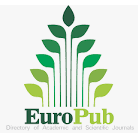Characterisation of Asystasia Gangetica and Phyllanthus Niruri Extracts: Total Phenolic Content, Antioxidant and Antibacterial Activities
Keywords:
Asystasia gangetica, Phyllanthus Niruri, Antioxidant Activity, Total Phenolic Content, Antibacterial Activity.Abstract
Antioxidant plays a significant role in inhibiting and scavenging free radicals, which protects human against infection and degenerative diseases. Nowadays, most studies focus on “natural antioxidants†from herbs due to safe therapeutic. In this study, performance on different extraction methods, i.e. Soxhlet, cold maceration and traditional extraction method assisted with ultrasonic-assisted extraction (UAE) for Asystasia gangetica leaves and Phyllanthus niruri plant are investigated by means of antioxidant, total phenolic content and antibacterial activity. The extracts were characterized for its antioxidant activity and total phenolic content by means of DPPH radical scavenging method and Folin-Ciocalteau reagent respectively. Optimization studies were carried out on combined cold-maceration and UAE extraction method by using Response Surface Method. Then, the optimized extracts were further characterized for antibacterial activity using Escherichia coli and Staphylococcus epidermidis by the agar disc diffusion method. Sample containing cold macerated A. gangetica and P. niruri indicates the highest antioxidant property as it contains the highest percentage of DPPH scavenging activity (59.57% and 51.14% respectively). While, the total phenolic content of macerated A. gangetica and P. niruri are 2.73 mg GAE/g and 2.68 mg GAE/g respectively. Consequently, after the determination of highest percentage of DPPH scavenging activity, the extracts were further optimized using UAE. From the optimization, the optimum condition was determined to be power of 17.57±0.01W and time of 5.83±0.01minutes for A. gangetica while, the power of 98.14±0.01W and 0.17±0.01minutes for P. niruri. Both optimized extracts showed potent antibacterial activity with high degree of antibacterial against E. coli. In conclusion, combination of cold maceration and UAE method increase the amount of antioxidant from extracts of A. gangetica and P. niruri. The finding from this study can be useful in pharmaceutical and cosmeceutical industries.
Keywords: Asystasia gangetica, Phyllanthus Niruri, Antioxidant Activity, Total Phenolic Content, Antibacterial Activity.











